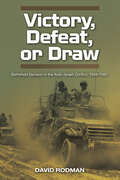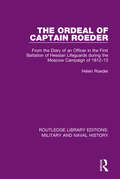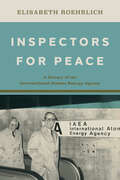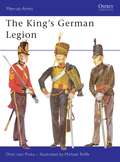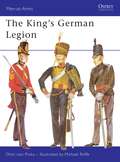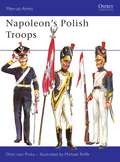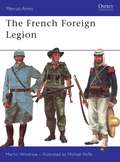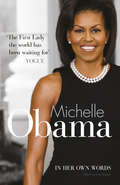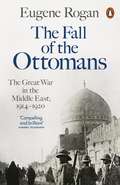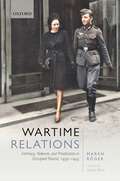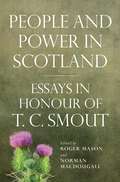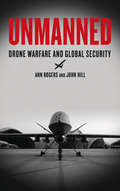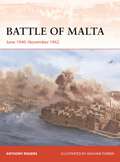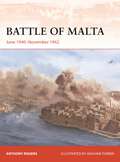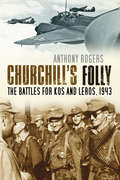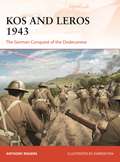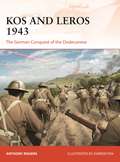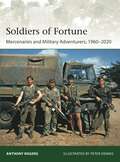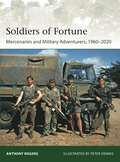- Table View
- List View
Sword & Shield of Zion: The Israel Air Force in the ArabIsraeli Conflict, 1948-2012
by David RodmanThe Israel Air Force (IAF) has accumulated as much battle experience as any air force in the world during the post-Second World War era, and it has recorded many outstanding accomplishments throughout a seemingly endless string of interstate wars, asymmetrical wars, counterinsurgency campaigns, and special operations. This book examines the IAF's experience in the ArabIsraeli conflict from the establishment of Israel in 1948 to the present day. It analyses this experience through the prisms of manoeuvre warfare, attrition warfare, counterinsurgency warfare, special operations, and humanitarian operations. The book reviews the IAF's performance in such wars as the 1967 Six-Day War, the 196970 War of Attrition, the 1973 Yom Kippur War, the 2006 Second Lebanon War, and the 20089 Gaza War. The book also scrutinizes the IAF's participation in major counterinsurgency campaigns and special operations, traces the air force's experience with unmanned aerial vehicles (UAVs), which have occupied a very prominent place in air operations since the 1982 Lebanon War, and chronicles its experience with anti-aircraft defences and satellites. Up-to-date information on the IAF's bases, squadrons, and other infrastructure is provided as well. The book is based on personal visits to the IAF over the past few years, during which the author had the opportunity to tour bases, listen to lectures and briefings, and speak with numerous retired, reserve, and active duty officers.
Victory, Defeat, or Draw: Battlefield Decision in the Arab-Israeli Conflict, 1948-1982
by David RodmanThree outcomes are possible on the battlefield: victory, defeat, or draw. An adversary may defeat or be defeated by its adversary, or neither of the two may emerge victorious or vanquished. Observers of military history have long tried to identify the variables that determine victory, defeat, or draw. While most would certainly acknowledge that decisions on the battlefield are dictated by a combination of variables rather than by a lone circumstance, many observers nevertheless tend to stress a single variable -- for example, the number of fighting men and fighting machines deployed by the adversaries, or the operational doctrines employed by the opposing forces -- as far more significant to the explanations of these decisions than other variables. This book, in contrast, takes a multicausal approach to the question of victory, defeat, or draw, proposing that a combination of six organizational, materiel, and environmental variables are pivotal to the explanation of decision on the battlefield. Using the extensive history of the Israel Defense Forces, the book examines a sample of eight battles across the ArabIsraeli conflict from 1948 to 1982 in order to determine the collective impact of the six variables on the outcomes of these battles, concluding that this basket of variables captures much of the explanation behind victory, defeat, or draw on the battlefield, at least insofar as concerns the record of the IDF. While the research in this book is aimed primarily at military historians and military practitioners, it is fully accessible to any layperson interested in Israeli military history in particular or international military history in general.
Victory, Defeat, or Draw: Battlefield Decision in the Arab-Israeli Conflict, 1948-1982
by David RodmanThree outcomes are possible on the battlefield: victory, defeat, or draw. An adversary may defeat or be defeated by its adversary, or neither of the two may emerge victorious or vanquished. Observers of military history have long tried to identify the variables that determine victory, defeat, or draw. While most would certainly acknowledge that decisions on the battlefield are dictated by a combination of variables rather than by a lone circumstance, many observers nevertheless tend to stress a single variable -- for example, the number of fighting men and fighting machines deployed by the adversaries, or the operational doctrines employed by the opposing forces -- as far more significant to the explanations of these decisions than other variables. This book, in contrast, takes a multicausal approach to the question of victory, defeat, or draw, proposing that a combination of six organizational, materiel, and environmental variables are pivotal to the explanation of decision on the battlefield. Using the extensive history of the Israel Defense Forces, the book examines a sample of eight battles across the ArabIsraeli conflict from 1948 to 1982 in order to determine the collective impact of the six variables on the outcomes of these battles, concluding that this basket of variables captures much of the explanation behind victory, defeat, or draw on the battlefield, at least insofar as concerns the record of the IDF. While the research in this book is aimed primarily at military historians and military practitioners, it is fully accessible to any layperson interested in Israeli military history in particular or international military history in general.
Farewell to The Little Coffee Shop of Kabul
by Deborah RodriguezTHE LONG-AWAITED SEQUEL TO THE LITTLE COFFEE SHOP OF KABUL, THE BESTSELLER THAT CAPTURED THE HEARTS OF MILLIONS WORLDWIDE Kabul, August 2021 Sunny Tedder is back in her beloved coffee shop. After eight years away, she's thrilled to reunite with her Kabul 'family': Yazmina now runs a pair of women's shelters from the old cafe, and dreams of a bright future for her two young daughters. Her sister Layla has become an outspoken women's rights activist and, thanks to social media, is quite the celebrity. Kat, Sunny's friend from America, is wrapping up her year-long stay in the land of her birth, but is facing some unfinished business. And finally there's elderly den mother Halajan, whose secret new hobby is itself an act of rebellion. Then the US troops begin to withdraw - and the women watch in horror as the Taliban advance on the capital at ferocious speed...Set against the terrifying fall of Kabul in 2021, Deborah Rodriguez concludes her bestselling Little Coffee Shop trilogy with a heart-stopping story of resilience, courage and, most importantly, hope.Praise for Deborah Rodriguez'Eye-opening and uplifting' - Grazia 'Restores belief in humanity' - Daily Telegraph 'Heart-warming' - Cosmopolitan'Beguiling' - Woman 'Captivating and addictive' - Take a Break'Full of heart and intelligence' - Look Magazine
The Ordeal of Captain Roeder: From the Diary of an Officer in the First Battalion of Hessian Lifeguards During the Moscow Campaign of 1812-13 (Routledge Library Editions: Military and Naval History)
by Helen RoederOriginally published in 1960, Captain Franz Roeder’s ability to bring to life the rigours in the Hessian Lifeguards during Napoleon’s ill-fated invasion of Russia in 1812-13, together with Helen Roeder’s skilful narrative, make this book one of the most compelling accounts of the sufferings of the Napoleonic Army. This is both an impelling personal story and a document of outstanding historical interest.
The Ordeal of Captain Roeder: From the Diary of an Officer in the First Battalion of Hessian Lifeguards During the Moscow Campaign of 1812-13 (Routledge Library Editions: Military and Naval History)
by Helen RoederOriginally published in 1960, Captain Franz Roeder’s ability to bring to life the rigours in the Hessian Lifeguards during Napoleon’s ill-fated invasion of Russia in 1812-13, together with Helen Roeder’s skilful narrative, make this book one of the most compelling accounts of the sufferings of the Napoleonic Army. This is both an impelling personal story and a document of outstanding historical interest.
Inspectors for Peace: A History of the International Atomic Energy Agency (Johns Hopkins Nuclear History and Contemporary Affairs)
by Elisabeth RoehrlichThe first comprehensive, empirically grounded, and independent study of the history of the IAEA.The International Atomic Energy Agency, which sends inspectors around the world to prevent states from secretly developing nuclear bombs, has one of the most important jobs in international security. At the same time, the IAEA is a global hub for the exchange of nuclear science and technology for peaceful purposes. Yet spreading nuclear materials and know-how around the world bears the unwanted risk of helping what the agency aims to halt: the emergence of new nuclear weapon states. In Inspectors for Peace, Elisabeth Roehrlich unravels the IAEA's paradoxical mission of sharing nuclear knowledge and technology while seeking to deter nuclear weapon programs. Founded in 1957 in an act of unprecedented cooperation between the Cold War superpowers, the agency developed from a small technical bureaucracy in war-torn Vienna to a key organization in the global nuclear order. Roehrlich argues that the IAEA's dual mandate, though apparently contradictory, was pivotal in ensuring the organization's legitimacy, acceptance, and success. For its first decade of existence, the IAEA was primarily a scientific and technical organization; it was not until the Treaty on the Non-Proliferation of Nuclear Weapons entered into force in 1970 that the agency took on the far-reaching verification and inspection role for which it is now most widely known. While the Fukushima nuclear disaster and the Iran negotiations made the IAEA's name famous, the organization's remarkable history remains strikingly absent from public knowledge. Drawing on extensive archival research, including firsthand access to newly opened records at the IAEA Archives in Vienna, Inspectors for Peace provides the first comprehensive, empirically grounded, and independent study on the history of the IAEA. Roehrlich also interviewed leading policymakers and officials, including Hans Blix and Nobel Peace laureate Mohamed ElBaradei, the agency's former heads. This book offers insight not only for students, scholars, and policy experts but for anyone interested in the history of the nuclear age, the Cold War, and the role of international organizations in shaping our world.
Inspectors for Peace: A History of the International Atomic Energy Agency (Johns Hopkins Nuclear History and Contemporary Affairs)
by Elisabeth RoehrlichThe first comprehensive, empirically grounded, and independent study of the history of the IAEA.The International Atomic Energy Agency, which sends inspectors around the world to prevent states from secretly developing nuclear bombs, has one of the most important jobs in international security. At the same time, the IAEA is a global hub for the exchange of nuclear science and technology for peaceful purposes. Yet spreading nuclear materials and know-how around the world bears the unwanted risk of helping what the agency aims to halt: the emergence of new nuclear weapon states. In Inspectors for Peace, Elisabeth Roehrlich unravels the IAEA's paradoxical mission of sharing nuclear knowledge and technology while seeking to deter nuclear weapon programs. Founded in 1957 in an act of unprecedented cooperation between the Cold War superpowers, the agency developed from a small technical bureaucracy in war-torn Vienna to a key organization in the global nuclear order. Roehrlich argues that the IAEA's dual mandate, though apparently contradictory, was pivotal in ensuring the organization's legitimacy, acceptance, and success. For its first decade of existence, the IAEA was primarily a scientific and technical organization; it was not until the Treaty on the Non-Proliferation of Nuclear Weapons entered into force in 1970 that the agency took on the far-reaching verification and inspection role for which it is now most widely known. While the Fukushima nuclear disaster and the Iran negotiations made the IAEA's name famous, the organization's remarkable history remains strikingly absent from public knowledge. Drawing on extensive archival research, including firsthand access to newly opened records at the IAEA Archives in Vienna, Inspectors for Peace provides the first comprehensive, empirically grounded, and independent study on the history of the IAEA. Roehrlich also interviewed leading policymakers and officials, including Hans Blix and Nobel Peace laureate Mohamed ElBaradei, the agency's former heads. This book offers insight not only for students, scholars, and policy experts but for anyone interested in the history of the nuclear age, the Cold War, and the role of international organizations in shaping our world.
The King’s German Legion (Men-at-Arms #42)
by Michael Roffe Otto Von PivkaThe King's German Legion was the largest and most respected of the foreign corps which fought as integrated elements of the British Army during the Napoleonic Wars. The light and heavy cavalry, light and line infantry, and horse and foot artillery of the KGL made major contributions to Wellington's victories during the Peninsular War, and several units covered themselves with glory at Waterloo. This book offers a comprehensive overview of the KGL from its origins to its disbandment, including its uniforms, weapons, flags and standards. Meticulous illustrations offer unprecedented details of this impressive fighting force.
The King’s German Legion (Men-at-Arms #42)
by Michael Roffe Otto Von PivkaThe King's German Legion was the largest and most respected of the foreign corps which fought as integrated elements of the British Army during the Napoleonic Wars. The light and heavy cavalry, light and line infantry, and horse and foot artillery of the KGL made major contributions to Wellington's victories during the Peninsular War, and several units covered themselves with glory at Waterloo. This book offers a comprehensive overview of the KGL from its origins to its disbandment, including its uniforms, weapons, flags and standards. Meticulous illustrations offer unprecedented details of this impressive fighting force.
Napoleon’s Polish Troops (Men-at-Arms)
by Michael Roffe Otto Von PivkaIn 1795 the kingdom of Poland fell prey to her stronger neighbours, Russia, Prussia and Austria. Following the death of the king of Poland in 1798, his kingdom was divided among these three neighbouring powers. France became increasingly involved, and protested at Poland's treatment, offering refuge for Polish exiles. On 11 October 1796 the Polish Legion was formed in the French army by General Dombrowski and Napoleon. This book covers the uniforms, dress, organisation and equipment of the infantry, artillery, and cavalry of Napoleon's Polish Troops. Among the cavalry units covered are the Chasseurs and Lancers. This title also provides a summary of the Polish divisions' campaigns in Spain, Russia and within Poland itself.
Napoleon’s Polish Troops (Men-at-Arms #Vol. 45)
by Michael Roffe Otto Von PivkaIn 1795 the kingdom of Poland fell prey to her stronger neighbours, Russia, Prussia and Austria. Following the death of the king of Poland in 1798, his kingdom was divided among these three neighbouring powers. France became increasingly involved, and protested at Poland's treatment, offering refuge for Polish exiles. On 11 October 1796 the Polish Legion was formed in the French army by General Dombrowski and Napoleon. This book covers the uniforms, dress, organisation and equipment of the infantry, artillery, and cavalry of Napoleon's Polish Troops. Among the cavalry units covered are the Chasseurs and Lancers. This title also provides a summary of the Polish divisions' campaigns in Spain, Russia and within Poland itself.
The French Foreign Legion (Men-at-Arms)
by Michael Roffe Mr Martin WindrowIt is arguable that no group of fighting men in the history of European arms has been so misrepresented by ill-informed publicity as the French Foreign Legion. Though initially conceived in 1831 as a means of drafting recently discharged foreign soldiers to Algeria, the Legion has developed into a sophisticated force of motorized infantry, airborne troops and light armour. In this book, acclaimed French Army expert Martin Windrow examines the history and uniforms of the French Foreign Legion, from its service in the Carlist War of 1835-36 to World War II and beyond, debunking many of the prevalent myths surrounding this formidable force.
Michelle Obama In Her Own Words: In Her Own Words
by Lisa RogakThis fascinating, often-funny and sometimes-controversial collection of quotations from Michelle Obama gives a revealing insight into the life and mind of the new First Lady. Featuring her thoughts on the election campaign and how she sees her role in the White House, this timely and inspirational compendium draws on a range of sources including press interviews, speeches and Michelle's own writing to share her reflections on:- the juggling act between work and motherhood- her own journey from Chicago's South Side to Princeton and Harvard- the women who have influenced her, and- controversial issues such as racism and the war in Iraq.It's an inspiring collection that gives a quick and fascinating glimpse into this intriguing woman's view of the world.
The Fall of the Ottomans: The Great War in the Middle East, 1914-1920
by Eugene RoganThe final destruction of the Ottoman Empire - one of the great epics of the First World War, from bestselling historian Eugene RoganFor some four centuries the Ottoman Empire had been one of the most powerful states in Europe as well as ruler of the Middle East. By 1914 it had been drastically weakened and circled by numerous predators waiting to finish it off. Following the Ottoman decision to join the First World War on the side of the Central Powers the British, French and Russians hatched a plan to finish the Ottomans off: an ambitious and unprecedented invasion of Gallipoli...Eugene Rogan's remarkable new book recreates one of the most important but poorly understood fronts of the First World War. Despite fighting back with great skill and ferocity against the Allied onslaught and humiliating the British both at Gallipoli and in Mesopotamia (Iraq), the Ottomans were ultimately defeated, clearing the way for the making, for better or worse, of a new Middle East which has endured to the present.
Wartime Relations: Intimacy, Violence, and Prostitution in Occupied Poland, 1939-1945
by Maren RögerDuring the Second World War, all contact between German soldiers and Polish women – considered an ‘inferior race’ – was officially banned. Sexual encounters frequently took place, however. Some were consensual, while others were characterised by brutal violence, and women often sold their bodies as a means of survival. The army and SS constructed purpose-built brothels for their soldiers, but also banned and frequently punished loving relationships. In Wartime Relations, Historian Maren Röger gives a powerful account of these encounters and describes the actions of the army and the SS in regulating relations between soldiers and civilian women. Röger provides new and important insights into everyday life during the occupation, Nazi racial policy, and the fates of the women involved.
People and Power in Scotland: Essays in Honour of T. C. Smout
by Roger Mason and Norman MacdougallFew Scottish historians are better known than T. C. Smout and fewer still more deserving of the high esteem in which they are held. He has made an outstanding contribution to Scottish historical studies both as an academic discipline and as a subject of wide popular appeal. His retirement in 1991 after twelve years as Professor of Scottish History at the University of St Andrews diminished neither his interest not his output. It did, however, provide a fitting opportunity to honour his accomplishments. This collection of ten essays by his friends and colleagues at St Andrews is a measure of his enormous success in promoting Scottish history there and of their respect for his achievements. Ranging widely over the Scottish past – from the fifteenth to the nineteenth centuries, from high politics to popular protest, from shipwrecks to railway mania, form local social studies to the problem of national identity – the essays pay tribute to the depth of Smout’s historical understanding by reflecting the breadth of research that he has done so much to encourage.
Unmanned: Drone Warfare and Global Security
by Ann Rogers John HillDrones have become the controversial new weapon of choice for the US military abroad. Unmanned details the causes and deadly consequences of this terrifying new development in warfare, and explores the implications for international law and global peace. *BR**BR*Ann Rogers and John Hill argue that drones represent the first truly globalised technology of war. The book shows how unmanned systems are changing not simply how wars are fought, but the meaning of conflict itself. *BR**BR*Providing an unparalleled account of new forms of 21st century imperial warfare, Unmanned shows how drone systems dissolve the conventional obstacles of time and space that have traditionally shaped conflict in the international system. It considers the possibility that these weapons will become normalised in global conflict, raising the spectre of new, unpredictable and unaccountable forms of warfare.
Battle of Malta: June 1940–November 1942 (Campaign)
by Anthony RogersA detailed exploration of the land, sea and air units that defended Malta, and the repeated Axis attempts to bring the crucial Allied island fortress to its knees.On 11 June 1940, the British crown colony of Malta – which dominated the central Mediterranean and all-important sea routes to and from North Africa – was bombed for the first time by aircraft of the Italian Regia Aeronautica. The Italians were joined in their efforts by the German Luftwaffe in January 1941. Malta was effectively beleaguered for nearly two and a half years, dependent for survival on naval supply convoys and reliant for defence on often-outnumbered fighter aircraft and anti-aircraft guns. Anthony Rogers provides a retelling of these events, drawing on accounts from both sides. This work features carefully selected photographic images, some previously unpublished. Seven specially commissioned colour maps explore the stategic situation in the Mediterranean in this period, the military sectors into which Malta's defence was divided, and German minelaying operations around the island. The three stunning battlescene artworks and 3D BEVs show key events from the battle, including the 26 July 1941 German attack on the Grand Harbour, and the major Luftwaffe raid 21 March 1942.
Battle of Malta: June 1940–November 1942 (Campaign #381)
by Anthony RogersA detailed exploration of the land, sea and air units that defended Malta, and the repeated Axis attempts to bring the crucial Allied island fortress to its knees.On 11 June 1940, the British crown colony of Malta – which dominated the central Mediterranean and all-important sea routes to and from North Africa – was bombed for the first time by aircraft of the Italian Regia Aeronautica. The Italians were joined in their efforts by the German Luftwaffe in January 1941. Malta was effectively beleaguered for nearly two and a half years, dependent for survival on naval supply convoys and reliant for defence on often-outnumbered fighter aircraft and anti-aircraft guns. Anthony Rogers provides a retelling of these events, drawing on accounts from both sides. This work features carefully selected photographic images, some previously unpublished. Seven specially commissioned colour maps explore the stategic situation in the Mediterranean in this period, the military sectors into which Malta's defence was divided, and German minelaying operations around the island. The three stunning battlescene artworks and 3D BEVs show key events from the battle, including the 26 July 1941 German attack on the Grand Harbour, and the major Luftwaffe raid 21 March 1942.
Churchill's Folly: The Battles for Kos and Leros, 1943 (Cassell Military Trade Bks.)
by Anthony RogersIn autumn 1943 the Italian-held Dodecanese was the setting for the last decisive German invasion of the Second World War – and the last irreversible British defeat. After the Italian armistice that followed the downfall of Mussolini, Churchill seized the opportunity to open a new front in the eastern Mediterranean, thereby increasing the pressure against Germany and hoping to provide an incentive for Turkey to join the Allies. Rejected by the Americans, it was a strategy fraught with difficulties and doomed to fail. Spearheaded by the LRDG and SBS, British troops were dispatched to the Aegean with naval units, but little or no air cover. They were opposed by German assault troops with overwhelming air superiority. Within 3 months, German forces had seized nearly all of the Dodecanese, which was occupied until the end of the war.
Kos and Leros 1943: The German Conquest of the Dodecanese (Campaign)
by Anthony RogersThis title is an illustrated account of the autumn 1943 battle for the Dodecanese, as Winston Churchill attempted to secure the Aegean islands in the wake of the Italian armistice. The occupation was a gamble intended to increase pressure against Germany and at the same time possibly provide encouragement for Turkey to join the Allies. Spearheaded by the Special Boat Squadron and the Long Range Desert Group, garrison troops were deployed to the Italian-occupied Dodecanese, but they were too late to prevent the Germans from taking control of the key island of Rhodes and its all-important airfields. An all-out German offensive followed. Air force and naval units supported a series of assaults by infantry and paratroopers, including specialist forces of the Division Brandenburg. Within three months, only Castelorizzo was still in British hands. Rhodes, Kos and Leros remained under German occupation until May 1945 and the end of the war in Europe. The Dodecanese would be Adolf Hitler's last enduring victory – and the last enduring British-led defeat.
Kos and Leros 1943: The German Conquest of the Dodecanese (Campaign)
by Anthony RogersThis title is an illustrated account of the autumn 1943 battle for the Dodecanese, as Winston Churchill attempted to secure the Aegean islands in the wake of the Italian armistice. The occupation was a gamble intended to increase pressure against Germany and at the same time possibly provide encouragement for Turkey to join the Allies. Spearheaded by the Special Boat Squadron and the Long Range Desert Group, garrison troops were deployed to the Italian-occupied Dodecanese, but they were too late to prevent the Germans from taking control of the key island of Rhodes and its all-important airfields. An all-out German offensive followed. Air force and naval units supported a series of assaults by infantry and paratroopers, including specialist forces of the Division Brandenburg. Within three months, only Castelorizzo was still in British hands. Rhodes, Kos and Leros remained under German occupation until May 1945 and the end of the war in Europe. The Dodecanese would be Adolf Hitler's last enduring victory – and the last enduring British-led defeat.
Soldiers of Fortune: Mercenaries and Military Adventurers, 1960–2020 (Elite)
by Anthony RogersThis highly illustrated title traces the development of mercenary soldiering from individuals and small units in the African wars of the 1960s–90s to today's state-employed corporate military contractors.The phenomenon of mercenary soldiering has constantly recurred in the news since the 1960s and has always attracted lively interest. The concept of 'mercenaries' began in the former Belgian Congo during the 1960s when men such as Mike Hoare and Bob Denard assembled hundreds of military veterans to 'do the fighting' for a particular leader or faction. This idea soon evolved into small teams of individuals training and leading local forces with varying success; wars in Rhodesia and on South Africa's borders attracted foreign volunteers into national armed forces, and veterans of these conflicts later sought employment elsewhere as mercenaries. The wars in the former Yugoslavia also attracted foreign fighters inspired as much by political and religious motives as by pay. This picture then evolved again, as former officers with recent experience set up sophisticated commercial companies to identify and fill the needs of governments whose own militaries were inadequate. Most recently, the aftermath of wars in Iraq and Afghanistan has seen such contractors taking on some of the burden of long-term security off major national armies, while the subsequent rise of ISIS/Daesh has added a parallel strain of ideological volunteers. The author is well placed to describe how the face of mercenary soldiering has evolved and changed over 60 years. Using first-hand accounts, photos and detailed illustrations, this book presents a compelling snapshot of the life, campaigns and kit used by mercenary operatives engaged in fighting within both larger and more specific conflicts around the world.
Soldiers of Fortune: Mercenaries and Military Adventurers, 1960–2020 (Elite)
by Anthony RogersThis highly illustrated title traces the development of mercenary soldiering from individuals and small units in the African wars of the 1960s–90s to today's state-employed corporate military contractors.The phenomenon of mercenary soldiering has constantly recurred in the news since the 1960s and has always attracted lively interest. The concept of 'mercenaries' began in the former Belgian Congo during the 1960s when men such as Mike Hoare and Bob Denard assembled hundreds of military veterans to 'do the fighting' for a particular leader or faction. This idea soon evolved into small teams of individuals training and leading local forces with varying success; wars in Rhodesia and on South Africa's borders attracted foreign volunteers into national armed forces, and veterans of these conflicts later sought employment elsewhere as mercenaries. The wars in the former Yugoslavia also attracted foreign fighters inspired as much by political and religious motives as by pay. This picture then evolved again, as former officers with recent experience set up sophisticated commercial companies to identify and fill the needs of governments whose own militaries were inadequate. Most recently, the aftermath of wars in Iraq and Afghanistan has seen such contractors taking on some of the burden of long-term security off major national armies, while the subsequent rise of ISIS/Daesh has added a parallel strain of ideological volunteers. The author is well placed to describe how the face of mercenary soldiering has evolved and changed over 60 years. Using first-hand accounts, photos and detailed illustrations, this book presents a compelling snapshot of the life, campaigns and kit used by mercenary operatives engaged in fighting within both larger and more specific conflicts around the world.

